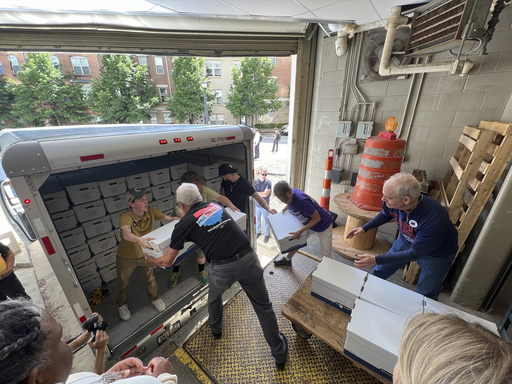COLUMBUS, Ohio (AP) — Backers of a proposal to change Ohio’s troubled political mapmaking system delivered hundreds of thousands of signatures on Monday as they work to qualify for the statewide ballot this fall.
Citizens Not Politicians dropped off more than 700,000 petition signatures to Republican Ohio Secretary of State Frank LaRose’s office in downtown Columbus, according to Jen Miller, director of League of Women Voters. LaRose now will work with local election boards to determine that at least 413,446 signatures are valid, which would get the proposal onto the Nov. 5 ballot.
The group’s amendment aims to replace the current Ohio Redistricting Commission, made up of three statewide officeholders and four state lawmakers, with an independent body selected directly by citizens. The new panel’s members would be diversified by party affiliation and geography.
Their effort to make the ballot was plagued by early delays. Republican Attorney General Dave Yost raised two rounds of objections to their petition language before wording was initially certified. Then, after the Ohio Ballot Board unanimously cleared the measure in October 2023, organizers were forced to resubmit their petitions due to a single-digit typo in a date.
“It’s just a great day for Ohio and Ohio’s democracy,” Miller said. “Citizens across the state came together to make sure we could get on the ballot this fall and finally end gerrymandering.”
The effort follows the existing structure’s repeated failure to produce constitutional maps. During the protracted process for redrawing district boundaries to account for results of the 2020 Census, challenges filed in court resulted in two congressional maps and five sets of Statehouse maps being rejected as unconstitutionally gerrymandered.
A month after the ballot campaign was announced, the bipartisan Ohio Redistricting Commission voted unanimously to approve new Statehouse maps, with minority Democrats conceding to “better, fairer” maps that nonetheless continued to deliver the state’s ruling Republicans a robust political advantage.
That same September, congressional district maps favoring Republicans were put in place, too, after the Ohio Supreme Court dismissed a group of legal challenges at the request of the voting-rights groups that had brought them. The groups told the court that continuing to pursue the lawsuits against the GOP-drawn maps brought turmoil not in the best interests of Ohio voters.
—
Rephrased content:
In Columbus, Ohio, advocates of altering the state’s political mapmaking system submitted over 700,000 signatures on Monday in hopes of making it onto the statewide ballot in the upcoming fall election. The group, Citizens Not Politicians, presented the signatures to Republican Ohio Secretary of State Frank LaRose’s office in downtown Columbus. Jen Miller, the director of League of Women Voters, confirmed the submission.
The proposal by Citizens Not Politicians intends to replace the current Ohio Redistricting Commission, consisting of three statewide officeholders and four state lawmakers, with an independent entity chosen directly by citizens. The new panel would represent a mix of party affiliations and geographic areas.
The road to getting the proposal on the ballot faced obstacles. Republican Attorney General Dave Yost raised objections to the petition language multiple times before the wording was initially approved. Furthermore, a typographical error in a date forced organizers to resubmit their petitions after the Ohio Ballot Board had unanimously greenlighted the measure in October 2023.
Director Jen Miller expressed her enthusiasm, stating, “It’s just a great day for Ohio and Ohio’s democracy. Citizens across the state came together to make sure we could get on the ballot this fall and finally end gerrymandering.”
This move comes as the current system has repeatedly failed to create constitutional maps. Challenges in court during the redrawing of district boundaries following the 2020 Census led to the rejection of two congressional maps and five sets of Statehouse maps for being unconstitutionally gerrymandered.
In a separate development, the bipartisan Ohio Redistricting Commission unanimously approved new Statehouse maps a month after the ballot campaign was announced. Despite minority Democrats acknowledging the new maps as “better, fairer,” they still provided significant political advantage to the state’s ruling Republicans.
Around the same time, congressional district maps that leaned in favor of Republicans were also established following the Ohio Supreme Court’s dismissal of legal challenges. Voting-rights groups behind the lawsuits chose to halt their fight against the GOP-drawn maps, asserting that the legal battles were not in the best interests of Ohio voters.


